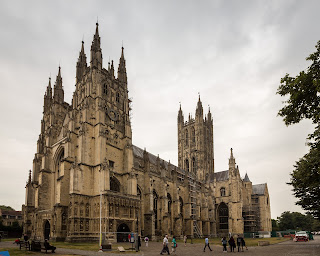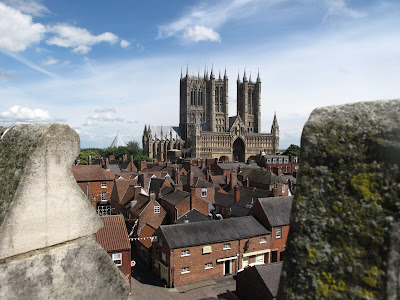Pottering around with hidden haloes in Gloucester
Gloucester Cathedral, formally the Cathedral of St. Peter and the Holy and Invisible Trinity, stands in the north of the city near the River Severn. It was built in 678 with the foundations of an abbey dedicated to St. Peter: later to be dissolved by Henry III.
The cathedral consists of a Norman nave with additions in every style of Gothic architecture. It is 420' long, 144' wide with a fine 16th century central tower rising to 225' topped by 4 pinnacles that are considered to be a local landmark.
The crypt, nave and chapter-house date from the 11th century; the crypt being one of four apsidal cathedral crypts in England with the others in Worcester, Winchester and Canterbury. The nave was begun in 1089 and the church largely completed by 1100. In the early 12th century, the western towers were added following the collapse of the south tower in1165.
In 1222, a fire damaged the timber roof of the monastic buildings. To repair the damage, and update the architectural style, an ambitious building campaign was launched to include re-vaulting of the nave Early English style (completed in 1237), the rebuilding of the collapsed south tower (completed in 1246) and the rebuilding of the refectory.
The south aisle was rebuilt in 1318-29. The pilgrimage to the tomb of Edward II(d. 1327) brought a huge influx of money that enabled the rebuilding and redecoration of the south transept (1329-37), north transept (1368-73) and the choir (1350-77).
The most notable monument is the canopied shrine to Edward II of England who was murdered at nearby Berkley Castle. The building and sanctuary were enriched by the visits of pilgrims to this shrine. In a side-chapel is a monument in coloured bog oak of Robert Curthose, eldest son of William the Conqueror and a great benefactor of the abbey, who was interred there. Other monuments of note are to William Warburton (Bishop of Gloucester) and Edward Jenner (physician) who, through studies with cowpox is responsible for the eradication of smallpox and introducing vaccination as a means of infection control.
During school terms, the cathedral is used for assemblies (known as morning chapel) by the King's School, Gloucester. It is also used for degree ceremonies for the nearby University of Gloucester and is in fairly regular use as a location site for film and television productions, most notably featuring in the Harry Potter series in 'The Philosopher's Stone' and 'The Chamber of Secrets' where the atmospheric cloisters were transformed into the corridors of Hogwart's School of Witchcraft and Wizardry.
Unfortunately anything that would give away the set as a church had to disappear, therefore the haloes on the stained glass figures in the cloister windows were painstakingly covered with coloured plastic filter paper to blend in with the surrounding glass and figures of Adam and Eve, in one window, were given clothes and the trademark Harry Potter 'lightning flash' on their foreheads in case they appeared in camera shot!








Comments
Post a Comment